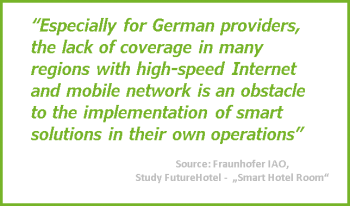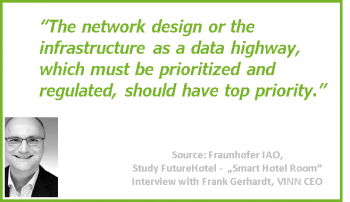
It goes without saying that technology and its target-oriented use is a deciding factor in shaping the digital transformation. But technology means so much more than just working with new hard- or software, and the relevance of this is much greater than it might seem like at first glance: we are talking about the technical infrastructure and its influence on the development and expansion of digital solutions.
A Technical Obstacle: Digital Infrastructure
First and foremost, there is a technical basis for the entire digital transformation: our infrastructure. Looking at the announcements by the German federal government over the last ten years, nationwide broadband coverage has been promised and repeatedly withdrawn since 2009. One example of this is the target speed of 50 Mbit/s.  This objective was announced in 2010 and was meant to be reached in 75 per cent of households by 2014. In 2015, this deadline, which had formerly been postponed to 2018, was then cancelled again – for 50 Mbit/s, mind you. While other countries had already implemented a comprehensive fibre-based infrastructure with the resulting opportunities for the economy and society back then, in 2019, Germany still has not caught up in several regions, even with the profoundly weaker vectoring via copper cable. The drama properly unfolds when taking into account the education sector: While a good 26 per cent of schools have Wi-Fi access for teaching staff and pupils in Germany, this figure comes up to ca. 59 per cent in Kazakhstan, 77 per cent in Uruguay and 100 per cent in Denmark! Against the backdrop these examples offer, it is clear that we need to work quickly on expanding our infrastructure towards using optical fibre cable.
This objective was announced in 2010 and was meant to be reached in 75 per cent of households by 2014. In 2015, this deadline, which had formerly been postponed to 2018, was then cancelled again – for 50 Mbit/s, mind you. While other countries had already implemented a comprehensive fibre-based infrastructure with the resulting opportunities for the economy and society back then, in 2019, Germany still has not caught up in several regions, even with the profoundly weaker vectoring via copper cable. The drama properly unfolds when taking into account the education sector: While a good 26 per cent of schools have Wi-Fi access for teaching staff and pupils in Germany, this figure comes up to ca. 59 per cent in Kazakhstan, 77 per cent in Uruguay and 100 per cent in Denmark! Against the backdrop these examples offer, it is clear that we need to work quickly on expanding our infrastructure towards using optical fibre cable.
A Technical Requirement: High-Performance Network Infrastructure
The second technical component of exceptional importance is the network infrastructure. As we have noted previously, China’s “digital revolutionaries” are more than one step ahead of us. However, especially in their lighthouse projects, they have the advantage to be able to plan their technologies on the “greenfield” from the very beginning. Naturally, it is more difficult to work with what you already have in stock, more so during ongoing business. In Europe what had to be or was supposed to be supplemented was, thus, often added little by little. This strategy obviously comes at the expense of a uniform approach. Ultimately, it is not an approach of taking calculated steps in the digital world, but just a reaction to what is going to be absolutely necessary! The obstacles we will now face require a paradigm shift. We need to be fast in the expansion of our network but without losing focus to negligible details and individual solutions. Rather, it is important, to capture our current performance to evaluate our target in cooperation with a competent partner. This results in a profile of requirements and solutions which, given appropriate planning, will remain attainable in the long run. Here, the keywords are network design, open interfaces and architecture up to the possibly desired step-by-step installation of the technologies, tailored to an individual customer’s specifications and their budget.
A Feasible Approach: Platform Instead of Islands
Even with these technical prerequisites, the rapid expansion of modern and efficient hotel technology is possible: with a platform solution! Instead of individual apps or isolated solutions with technical limitations, an adequately developed and configured platform represents a future-proof investment thanks to its open interfaces.  It can either be used to make the big move directly towards a complete solution or to gradually expand the portfolio with the desired technical solutions and their functions. Additionally, even when other requirements emerge in the future, other technologies can easily be integrated. Platforms also offer a huge advantage in terms of the following aspects: Everything is installed in one place, can, therefore, be complemented conveniently by other modules and administered more cost-efficiently!
It can either be used to make the big move directly towards a complete solution or to gradually expand the portfolio with the desired technical solutions and their functions. Additionally, even when other requirements emerge in the future, other technologies can easily be integrated. Platforms also offer a huge advantage in terms of the following aspects: Everything is installed in one place, can, therefore, be complemented conveniently by other modules and administered more cost-efficiently!
The guests can also be involved immediately, because they already bringing THEIR device with them, the smartphone. The hardware investment by the hotel is not only eliminated but the smartphone, the guest’s everyday instrument, can also be utilised for numerous services within the hotel: to chat, as a digital room key or streaming device and much more. So, one factor for a seamless, digital travel experience is already accounted for. Hence, it can and should be used to ‘bundle’ the events and touchpoints during the guest’s stay at the hotel. What other doors the involvement of the guests’ smartphones opens will be explored in the next chapters of our blog.
Yours sincerely
Frank Gerhardt, VINN CEO
We use the service AddToAny for sharing.